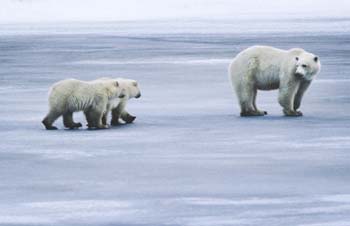
Copyright © Noella Ballenger
Bear babies learn to follow Mom and stay right with her as she watches carefully for male bears or other dangers.
Polar bear foot pads are rough enough to provide traction on the ice but are thickly furred and immune to frost bite. The bears’ sense of smell is phenomenal. They’re able to detect young seals hiding in a snow cave buried under three feet of snow from nearly a mile away. Their vision tends to be farsighted to enable them to scan the landscape easily, and their hearing is comparable to that of humans.
When the bears gather to wait for the ice to form, their main activity seems to be sleeping. However, the youngsters indulge in frequent mock fighting. During these fights, they’ll rough-house, chase, stand up and slam each other, and then take a break to cool down. They may eat snow or lie with their entire bodies spread-eagled across the snow to cool off their tummies. Once they’re comfortable again, they’ll probably get up and resume the play fighting and chasing.
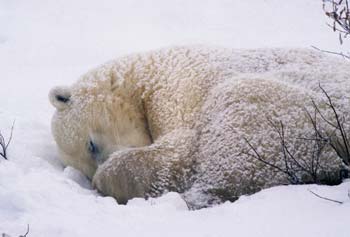
Copyright © Noella Ballenger
Bears will dig small holes or depressions in the snow and snuggle in for a nap.
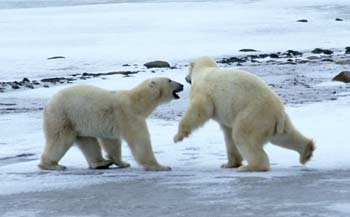
Copyright © Noella Ballenger
Sparring and rough play among young bears is training for the time when they may need to fight.
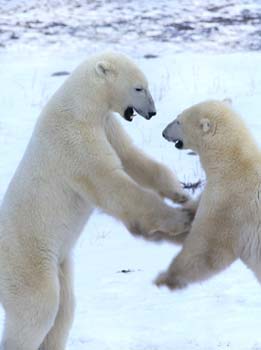
Copyright © Noella Ballenger
Watching two adult bears fight is amazing.
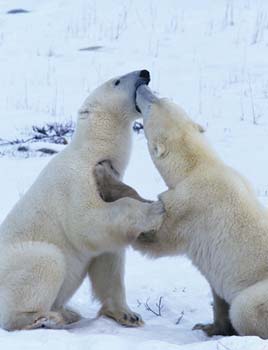
Copyright © Noella Ballenger
“Mouthing” is a part of bear behavior.
Man is the only predator of adult polar bears. However, the cub’s worst enemy is the adult male bear. In the bear world, a female will not come into estrous while she has cubs, so a male will kill the cubs if he can. Polar bear courtship and mating take place on the sea ice and occur about the same time as the birth of thousands of seal pups. This “coincidence” insures an abundant food supply for the expectant mother bear. The expectant females den in the winter and nurse their young for at least five months before being able to hunt again. The family (mother and cubs only) remains together for about one-and-a-half to two years before the cubs go off on their own. When they do leave their mothers, it’s not uncommon for a number of these young cubs to band together until they’re mature enough to start their own families (at about five years of age).
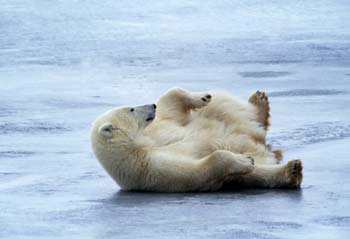
Copyright © Noella Ballenger
After fighting, the bears stretch out on the ice or in the snow to cool off.
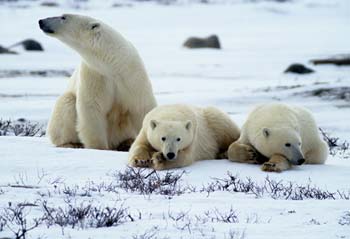
Copyright © Noella Ballenger
Bears are excellent mothers. The babies stay with their mother for about a year and a half before they go off on their own.
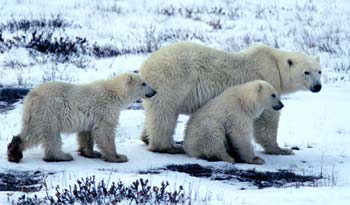
Copyright © Noella Ballenger
The male bear will attempt to kill the babies if they can to bring the female into estrus in order to mate.
The characteristics that I found most unusual in my observations of the polar bears is their curiosity, remarkable lack of fear near man, and their playfulness–both when they’re alone and when they’re with other bears. This penchant for fun changes as they begin hunting for food and dedicating their energies to survival. While they wait for the pack ice to form, the bears are most enjoyable to watch.
When you’re photographing the polar bear, it’s important for you to capture the naturalness in their expressions and activities. Sometimes, you need to just wait for some action to take place. A great shot requires lots of patience. Here are some of the basics that are helpful to keep in mind when you’re photographing polar bears or any wild “critter”: As always, keeping the camera steady is very important, as is using the proper exposure and thinking about the general composition. Remember that you’re generally photographing a white object on a white background. Therefore, you may need to overexpose to get a “white” and not a middle-tone gray. One of the delights of digital cameras is that histograms can be checked and images reviewed during the shoot.
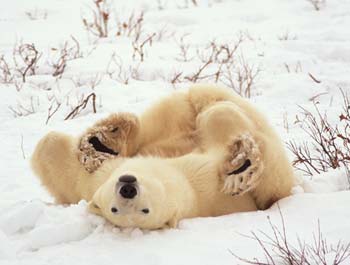
Copyright © Noella Ballenger
Some of the youngsters were quite playful … rolling and tumbling in the snow.
When I know that I’ll be photographing a certain kind of animal, I like to visit our local zoo and spend several hours watching that species. I realize that the behavior exhibited in the zoo may not be similar to the behavior exhibited in the wild, but somehow this observation builds my confidence and starts me thinking about how that animal acts and moves. I also turn to the Internet and public library for more information. I seek out the work of other photographers–not to copy, but to understand and to help me prepare for possible conditions and behaviors. It’s only after I do my homework that I feel prepared for a trip. As a matter of fact, when I look back at this trip, I realize that there’s so much more I could do and should have done to make my results better. I guess I’ll just have to go back to do it again!. See you in Churchill!
Back to beginning of the Polar Bear article…..
by Noella Ballenger

Leave a Reply